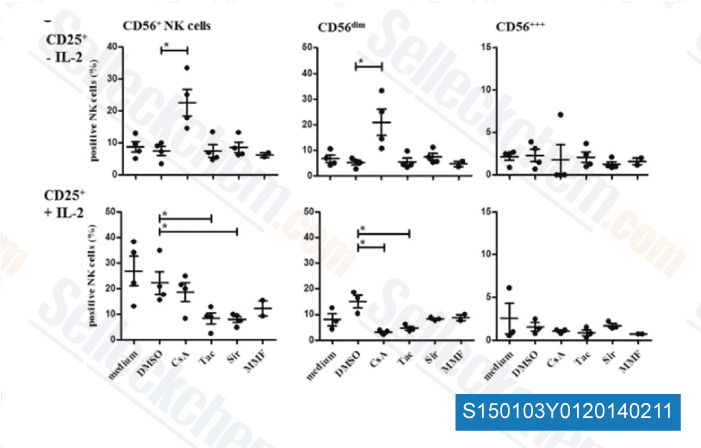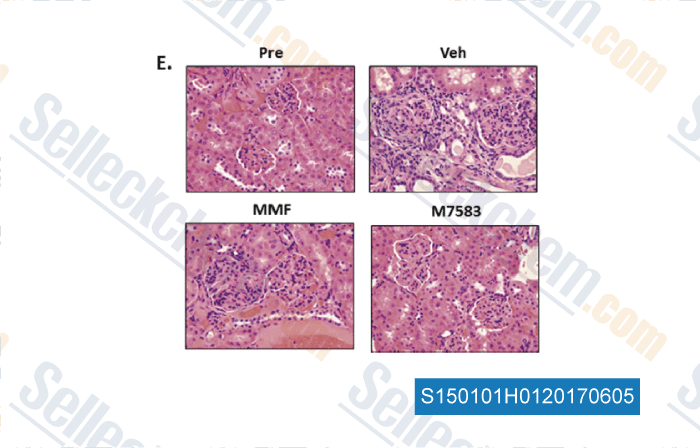|
Toll Free: (877) 796-6397 -- USA and Canada only -- |
Fax: +1-832-582-8590 Orders: +1-832-582-8158 |
Tech Support: +1-832-582-8158 Ext:3 Please provide your Order Number in the email. |
Technical Data
| Formula | C23H31NO7 |
||||||
| Molecular Weight | 433.49 | CAS No. | 128794-94-5 | ||||
| Solubility (25°C)* | In vitro | DMSO | 86 mg/mL (198.38 mM) | ||||
| Water | Insoluble | ||||||
| Ethanol | Insoluble | ||||||
| In vivo (Add solvents to the product individually and in order) |
|
||||||
|
* <1 mg/ml means slightly soluble or insoluble. * Please note that Selleck tests the solubility of all compounds in-house, and the actual solubility may differ slightly from published values. This is normal and is due to slight batch-to-batch variations. * Room temperature shipping (Stability testing shows this product can be shipped without any cooling measures.) |
|||||||
Preparing Stock Solutions
Biological Activity
| Description | Mycophenolate mofetil is a non-competitive, selective and reversible inhibitor of inosine monophosphate dehydrogenase I/II with IC50 of 39 nM and 27 nM, respectively. This compound induces caspase-dependent apoptosis and cell cycle inhibition in multiple myeloma cells. | ||||
|---|---|---|---|---|---|
| Targets |
|
||||
| In vitro | Mycophenolate mofetil is an ester prodrug of the active immunosuppressant mycophenolic acid (MPA). The latter shows a noncompetitive, selective and reversible inhibition activity against inosine monophosphate dehydrogenase type I/II with IC50 of 39 nM and 27 nM, respectively. Moreover, MPA also produces the concentration-dependent inhibition of proliferation of ConA-stimulated T cells, LPS-stimulated B cells and alloantigen-specific T cells with IC50 of 100 nM, 120 nM, and 51 nM, respectively. [1] This compound with high concentration of 10 μg/mL induces a strong apoptosis in microglial cell cultures and increases the number of activated caspase-3 immunoreactive apoptotic cells. In addition, it (1 μg/mL) strongly inhibits proliferation of both microglial cells and astrocytes. [2] A recent study shows that this chemical significantly attenuates the extent of neuronal cell death of organotypic hippocampal slice cultures after neuronal injury in a time-dependent manner. [4] |
||||
| In vivo | In an ACI-to-Lewis rat heterotopic cardiac transplant model, treatment of Mycophenolate mofetil at doses of 20 mg/kg and 40 mg/kg leads to a prolongation of graft survival, with median survival time (MST) of 14.5 days and 18.5 days, respectively. [1] In bleomycin (BLM)-induced scleroderma mouse model, this compound reduces inflammatory-cell infiltration, tissue hydroxyproline content and dermal thickness. [3] |
Protocol (from reference)
| Kinase Assay: |
|
|---|---|
| Cell Assay: |
|
| Animal Study: |
|
References
|
Customer Product Validation

-
Data from [ Front Immunol , 2013 , 4, 46 ]

-
Data from [ Front Immunol , 2013 , 4, 46 ]

-
Data from [ Front Immunol , 2013 , 4:, 46 ]

-
Data from [ , , Clin Immunol, 2016, 164:65-77 ]
Selleck's Mycophenolate mofetil Has Been Cited by 14 Publications
| Genome-scale clustered regularly interspaced short palindromic repeats screen identifies nucleotide metabolism as an actionable therapeutic vulnerability in diffuse large B-cell lymphoma [ Haematologica, 2024, 109(12):3989-4006] | PubMed: 38841800 |
| Spatiotemporal Regulation of De Novo and Salvage Purine Synthesis during Brain Development [ eNeuro, 2023, 10(10)ENEURO.0159-23.2023] | PubMed: 37770184 |
| Spatiotemporal Regulation of De Novo and Salvage Purine Synthesis during Brain Development [ eNeuro, 2023, 10(10)ENEURO.0159-23.2023] | PubMed: 37770184 |
| Spatiotemporal regulation ofde novoand salvage purine synthesis during brain development [ bioRxiv, 2023, 10.1101/2023.03.01.530588] | PubMed: None |
| Reversal of cancer gene expression identifies repurposed drugs for diffuse intrinsic pontine glioma [ Acta Neuropathol Commun, 2022, 10(1):150] | PubMed: 36274161 |
| Comprehensive drug response profiling and pan-omic analysis identified therapeutic candidates and prognostic biomarkers for Asian cholangiocarcinoma [ iScience, 2022, 25(10):105182] | PubMed: 36248745 |
| GATA4 regulates mitochondrial biogenesis and functions during cardiac development and rescues cardiac and mitochondrial functions impaired by TKIs [ Research Square, 2022, Version 1] | PubMed: None |
| The effect of nintedanib versus mycophenolate mofetil in the Fra2 mouse model of systemic sclerosis-associated interstitial lung disease [ Clin Exp Rheumatol, 2021, N/A] | PubMed: 33886452 |
| Purine metabolism regulates DNA repair and therapy resistance in glioblastoma [ Nat Commun, 2020, 11(1):3811] | PubMed: 32732914 |
| IMPDH Inhibitors for Antitumor Therapy in Tuberous Sclerosis Complex [ JCI Insight, 2020, 9;5(7):e135071] | PubMed: 32271165 |
RETURN POLICY
Selleck Chemical’s Unconditional Return Policy ensures a smooth online shopping experience for our customers. If you are in any way unsatisfied with your purchase, you may return any item(s) within 7 days of receiving it. In the event of product quality issues, either protocol related or product related problems, you may return any item(s) within 365 days from the original purchase date. Please follow the instructions below when returning products.
SHIPPING AND STORAGE
Selleck products are transported at room temperature. If you receive the product at room temperature, please rest assured, the Selleck Quality Inspection Department has conducted experiments to verify that the normal temperature placement of one month will not affect the biological activity of powder products. After collecting, please store the product according to the requirements described in the datasheet. Most Selleck products are stable under the recommended conditions.
NOT FOR HUMAN, VETERINARY DIAGNOSTIC OR THERAPEUTIC USE.
